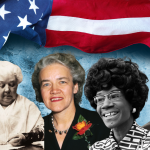Harriet Tubman didn’t give a damn about the rules. She wasn’t just an escapee from slavery; she risked her life in 13 expeditions to lead 70 others to escape the shackles of oppression. In this audacious journey, she defied slave catchers, the oppressive Fugitive Slave Act, and the authority of enslavers and never once wavered. Her remarkable courage turned the tide of the Civil War by gathering intelligence for the Union while also championing the cause of women’s suffrage — these are just a few of the remarkable accomplishments of one of America’s most courageous heroes.
Early Life and Slavery
Harriet Tubman, originally Araminta Ross or Minty, was born in Dorchester County, Maryland, around the early 1820s. Her parents, Harriet “Rit” Green and Ben Ross were both enslaved, and Minty was one of their nine children. Two of her older sisters were sold to a chain gang (Prisoner labor with chains).
Minty’s mother worked in the “big house,” so she looked after her younger brother and a baby. At five or six, she became a nursemaid for “Miss Susan”. Her duties included caring for the baby and rocking the cradle. Whenever the baby cried, Minty was subjected to whippings. One day, she got hit five times before breakfast, leaving her with scars for life. In her efforts to resist, Minty sometimes ran away for several days, wore layers of clothing for protection, and even fought back.
During her childhood, Minty was also sent to work for a planter named James Cook, checking muskrat traps in nearby marshes, even when she was sick with measles. Her illness became so severe that Cook sent her back to Brodess, where her mother nursed her back to health. However, she was soon hired out again.
During her teenage years, Minty suffered a head injury from a metal weight thrown by an overseer. This injury resulted in her experiencing narcoleptic sleeping spells for the rest of her life. Minty’s owner attempted to sell her, but the presence of these spells made her undesirable to buyers.
Instead, she was put to work with her father, Ben Ross. He taught her how to lumber. It increased her physical strength and brought her into contact with free black sailors involved in shipping wood to the North. From these sailors, she learned about secret communications along trade routes, knowledge that would prove invaluable later in her life.
Around 1844, Harriet married a free black man, John Tubman. Their marriage was complicated because her enslaved status meant any children they had would also be enslaved. Such mixed marriages were common in the region. Harriet changed her name from Araminta to Harriet, choosing her mother’s name for religious or familial reasons.
The Escape to Freedom
In 1849, after her owner’s death, there was a greater chance his widow would sell her, so Harriet decided to escape. On September 17, 1849, Harriet, along with her brothers Ben and Henry, escaped from slavery. She had been hired by Anthony Thompson, who owned a large plantation in Caroline County. It is likely her brothers also worked for Thompson. Eliza Brodess didn’t immediately recognize their absence as an escape attempt due to their hiring out. Two weeks later, she offered a reward for their capture in the local newspaper. Harriet’s brothers had second thoughts and returned, forcing her to return with them.
In October or November, Harriet escaped again. She used the Underground Railroad, a network of free and enslaved individuals, white abolitionists, and Quakers in Maryland. She likely followed a route northeast along the Choptank River, through Delaware, and into Pennsylvania, covering nearly 90 miles on foot.
Traveling by night, guided by the North Star, and avoiding slave catchers, Harriet relied on the Underground Railroad’s protection. At one stop, she pretended to work in the yard during the day, and the family hid her in a cart to take her to the next friendly house at night. Harriet, familiar with the region’s woods and marshes, probably hid there during the day.
The “Moses” of Her People
After arriving in Philadelphia, Harriet was worried about her family still in Maryland. She worked odd jobs to save money. In 1850, the Fugitive Slave Act made escaping slavery even riskier, pushing more escapees to seek refuge in Southern Ontario. Tensions grew in Philadelphia as Irish immigrants competed with free blacks for work.
In December 1850, Harriet learned her niece Kessiah and her children faced being sold in Cambridge, prompting her to return to Baltimore. There, her brother-in-law sheltered her. Kessiah’s husband, John Bowley, a free black man, managed to purchase his wife at the auction. Under the cover of night, they sailed to Baltimore on a log canoe and reunited with Harriet in Philadelphia.
In late 1851, Harriet returned to her old county, Dorchester, in search of her husband, John. She found out he had married someone else named Caroline. Harriet tried to convince him to join her, but he refused. Despite her anger, she encountered other enslaved individuals seeking to escape, leading them to Philadelphia.
From 1851 to 1862, Harriet repeatedly traveled to the Eastern Shore of Maryland, rescuing approximately 70 enslaved people in about 13 expeditions. It included her brothers Henry, Ben, Robert, their wives, and some of their children. She also provided specific instructions to 50 to 60 additional enslaved individuals who sought their freedom. Her remarkable efforts earned her the nickname “Moses” because she led people to freedom, akin to the biblical prophet. One of her final missions in Maryland was to bring her aging parents to safety in St. Catharines, Canada, where a community of formerly enslaved people, including relatives and friends of Harriet, had gathered.
The 1850 Fugitive Slave Act enabled the capture of fugitive and freed workers in the North, making Harriet Tubman’s role as an Underground Railroad conductor more challenging. She guided enslaved people to Canada, often at night in spring or fall. Harriet carried a gun to deter any hesitation among those she helped. She sometimes gave sedatives to infants to avoid alerting slave catchers.
Over the next decade, Harriet worked with abolitionists like Frederick Douglass, forming her Underground Railroad network. While she’s credited with emancipating around 300 enslaved people, these numbers might be exaggerated. Nevertheless, she guided at least 70 to freedom and instructed many others.
Civil War & Later Years
During the Civil War, Harriet aided fugitive enslaved people at Fort Monroe and served as a nurse and scout. She also provided valuable intelligence to Union forces and helped form Black Union regiments.
After the war, Harriet settled in New York, married, and adopted a child. She engaged in philanthropy, supported women’s suffrage, and founded the Harriet Tubman Home for Aged and Indigent Colored People.
Harriet died due to pneumonia on March 10, 1913, but her legacy endures. Just before her death, she quoted the Bible verse of John 14:3 to those in the room:
“I go away to prepare a place for you.”
Numerous museums and schools bear her name, and her story has been presented in books, movies, and documentaries. In 2016, it was announced that her image would be on the $20 bill, with plans to accelerate the design process in 2021.
Today, Old slavery is gone, but new forms persist, like human trafficking, affecting millions, especially women and children, forced into labor and prostitution globally. It’s a reminder that the fight for freedom and fairness continues. We must work to end all slavery and ensure respect and fairness for everyone.
Author Profile
- Fizza Tanveer writes stories about history for The Feisty News. She resurrects lost stories with her pen-as-time machine. To her, history isn't mere facts and figures; instead, it's about understanding the past's impact on our world.
Latest Entries
 FEISTY WomenJanuary 13, 2024Women speak up to lead the fight to save America’s democracy
FEISTY WomenJanuary 13, 2024Women speak up to lead the fight to save America’s democracy CrimeJanuary 7, 2024Teenage girl is virtually gang-raped in Metaverse game
CrimeJanuary 7, 2024Teenage girl is virtually gang-raped in Metaverse game LifestyleJanuary 6, 2024Self-driving RoboTaxi’s offer an antidote to 7 Million annual air pollution deaths
LifestyleJanuary 6, 2024Self-driving RoboTaxi’s offer an antidote to 7 Million annual air pollution deaths World NewsDecember 24, 2023NASA aims to land the first woman on the moon in 2024
World NewsDecember 24, 2023NASA aims to land the first woman on the moon in 2024





